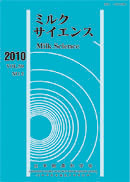Volume 59, Issue 3
Displaying 1-9 of 9 articles from this issue
- |<
- <
- 1
- >
- >|
Original Papers
-
2010Volume 59Issue 3 Pages 231-236
Published: 2010
Released on J-STAGE: March 15, 2014
Download PDF (239K) -
2010Volume 59Issue 3 Pages 237-253
Published: 2010
Released on J-STAGE: March 15, 2014
Download PDF (1545K)
Reviews (Anniversary Reviews for Awards)
-
2010Volume 59Issue 3 Pages 255-263
Published: 2010
Released on J-STAGE: March 15, 2014
Download PDF (538K)
-
2010Volume 59Issue 3 Pages 265-274
Published: 2010
Released on J-STAGE: March 15, 2014
Download PDF (641K)
-
2010Volume 59Issue 3 Pages 275-281
Published: 2010
Released on J-STAGE: March 15, 2014
Download PDF (629K)
-
2010Volume 59Issue 3 Pages 283-294
Published: 2010
Released on J-STAGE: March 15, 2014
Download PDF (607K)
-
2010Volume 59Issue 3 Pages 295-302
Published: 2010
Released on J-STAGE: March 15, 2014
Download PDF (673K)
-
2010Volume 59Issue 3 Pages 303-307
Published: 2010
Released on J-STAGE: March 15, 2014
Download PDF (322K)
-
2010Volume 59Issue 3 Pages 309-312
Published: 2010
Released on J-STAGE: March 15, 2014
Download PDF (509K)
- |<
- <
- 1
- >
- >|
